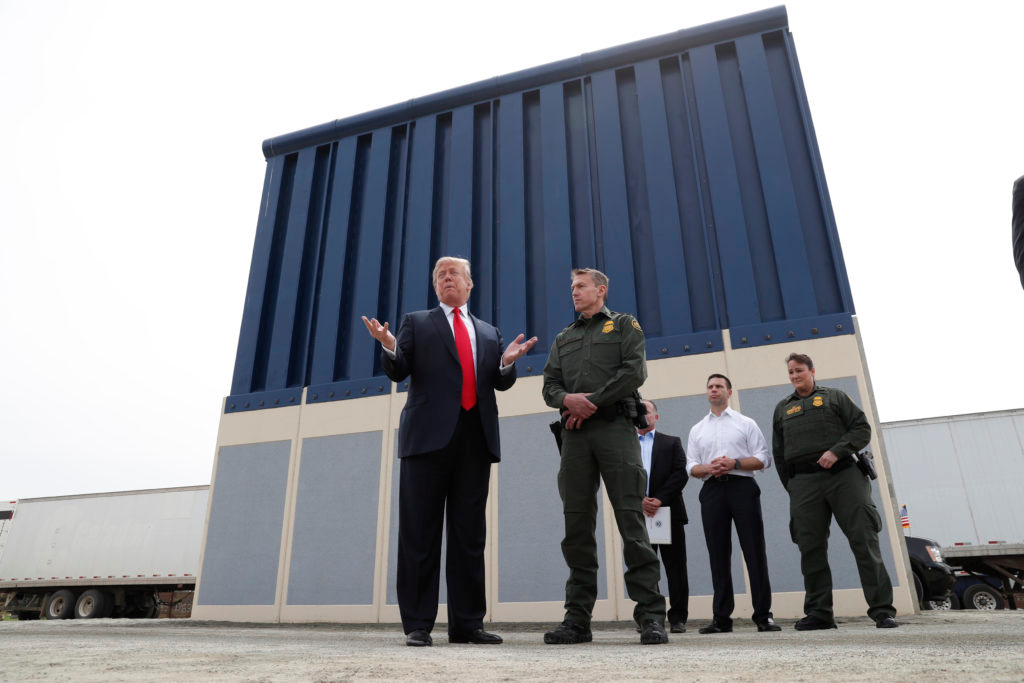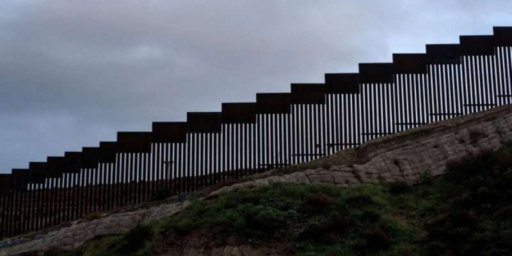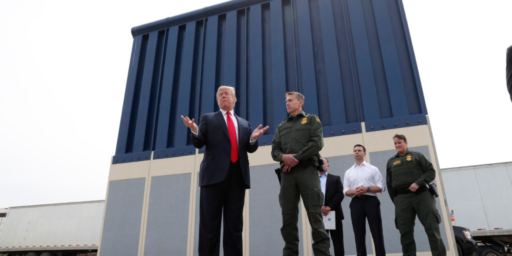Supreme Court Backs Trump On Border Wall Funding, For Now
The Supreme Court handed the President a victory last night, ruling that the Plaintiffs in a lawsuit challenging his funding of the border wall did not have standing to challenge his diversion of Defense Department funds. This may only be a temporary victory, though.

In an unusual summer ruling, the Supreme Court overruled a lower court injunction that barred the Trump Administration from using certain funds allocated to the military budget to build parts of his border wall at the southern border but it’s unclear what impact this decision will have on other lawsuits filed to block the Administration’s actions:
WASHINGTON — The Supreme Court on Friday gave President Trump a victory in his fight for a wall along the Mexican border by allowing the administration to begin using $2.5 billion in Pentagon money for the construction.
In a 5-to-4 ruling, the court overturned an appellate decision and said that the administration could tap the money while litigation over the matter proceeds. But that will most likely take many months or longer, allowing Mr. Trump to move ahead before the case returns to the Supreme Court after further proceedings in the appeals court.
While the order was only one paragraph long and unsigned, the Supreme Court said the groups challenging the administration did not appear to have a legal right to do so. That was an indication that the court’s conservative majority was likely to side with the administration in the end.
The court’s four more liberal justices dissented. One of them, Stephen G. Breyer, wrote that he would have allowed the administration to pursue preparatory work but not construction, which he said would be hard to undo if the administration ultimately lost the case.
President Trump promptly posted on Twitter that he was delighted with the ruling: “Wow! Big VICTORY on the Wall. The United States Supreme Court overturns lower court injunction, allows Southern Border Wall to proceed. Big WIN for Border Security and the Rule of Law!”
The ruling came on the same day that Mr. Trump signed an agreement with Guatemala that was intended to slow the flow of Central American migrants seeking refuge in the United States. Migrants who travel north through Guatemala will be required to seek asylum there first.
The border wall case, Trump v. Sierra Club, No. 19A60, concerned injunctions entered by a trial judge that blocked the transfer of military funds to wall construction. An appeals court refused to stay the trial judge’s ruling while it considered the administration’s appeal. The Supreme Court’s ruling on Friday allows construction to proceed while the litigation continues.
Dror Ladin, a lawyer with the American Civil Liberties Union, one of the groups behind the legal challenge, said the ruling was a temporary setback.
“We will be asking the federal appeals court to expedite the ongoing appeals proceeding to halt the irreversible and imminent damage from Trump’s border wall,” Mr. Ladin said. “Border communities, the environment, and our Constitution’s separation of powers will be permanently harmed should Trump get away with pillaging military funds for a xenophobic border wall Congress denied.”
Justice Breyer was the only member of the court to file an opinion. “This case raises novel and important questions about the ability of private parties to enforce Congress’s appropriations power,” he wrote. But the immediate issue for the court, he added, was merely whether to enter a stay of the trial court’s injunction.
Allowing construction to start, Justice Breyer wrote, could cause irreparable harm to the challengers and to the environment. On the other hand, he wrote, the administration could lose access to the funds if it did not finalize contracts by the end of September. The solution, he wrote, would be to let the government negotiate and sign contracts, but not start building.
“I would grant the government’s application to stay the injunction only to the extent that the injunction prevents the government from finalizing the contracts or taking other preparatory administrative action,” Justice Breyer wrote, “but leave it in place insofar as it precludes the government from disbursing those funds or beginning construction.”
Amy Howe comments at SCOTUSBlog:
The government urged the justices to allow it to go ahead and use the Pentagon funds for border-wall construction while it appeals the district court’s ruling to the 9th Circuit. It stressed the need to build the wall “to stanch the flow of illegal narcotics across the southern border,” and it urged the court to act on its request by July 26: If the construction contracts are not finalized by September 30, when the fiscal year ends, the government explained, they will no longer be available.
The challengers pushed back, countering that because Congress had declined to allocate money for the border wall, the government could not transfer money from the Pentagon to the Department of Homeland Security. Moreover, they added, once construction of the wall begins, “there will be no turning back.”
Tonight the Supreme Court granted the government’s request and put the lower court’s ruling on hold to give the government time to appeal. In a brief unsigned order, the court explained that, among other things, the government had made the showing required at this preliminary stage of the case that the Sierra Club and the SBCC may not be the right plaintiffs to challenge the reallocation of the funds.
Justices Ruth Bader Ginsburg, Sonia Sotomayor and Elena Kagan indicated that they would have denied the government’s request.
In a separate opinion, Justice Stephen Breyer noted that the challengers had argued that the construction of the wall would harm the environment, while the government had argued that its request should be granted to avoid a scenario in which the funds for the wall were no longer available after September 30 because the construction contracts had not been finalized. Breyer explained that he would have split the difference and allowed the government to finalize the contracts but not to begin construction.
Ilya Somin at The Volokh Conspiracy meanwhile notes, correctly, that this is hardly the end of the road for legal challenges to the funding for the border wall:
As is the usual practice with stay rulings, the majority issued very little in the way of an explanation. But it did indicate that “[a]mong the reasons is that the Government has made a sufficient showing at this stage that the plaintiffs have no cause of action to obtain review of the Acting Secretary’s compliance with Section 8005 [of the the 2019 Department of Defense Appropriations Act].”
In other words, this seems to be a purely a procedural ruling suggesting that the majority justices think the plaintiffs in the case—the Sierra Club and the Southern Border Community Coalition an alliance of various liberal/progressive groups in the border area—lacked the procedural right to challenge the diversion of funds. The Court may be referring here to Judge N. Randy Smith’s argument in his dissent in the Ninth Circuit ruling on this issue, where he argued that only plaintiffs with “economic interests” at stake are legally permitted to challenge the funding diversion. In my view, Judge Smith’s distinction between “economic” and “recreational” interests in dubious. The Court should have simply denied the stay, or at least adopted Justice Breyer’s approach.
But if Smith’s analysis is indeed the basis for the majority justices’ ruling, it is notable that it does not address the underlying merits of the legality of Trump’s plan to divert the funds. And, if the Supreme Court ultimately reverses the Ninth Circuit on this basis, the legal battle over the wall will be far from over.
In my view, Judge Smith’s distinction between “economic” and “recreational” interests in dubious. But, even if the Supreme Court ultimately endorses his reasoning or something like it, there are plenty of other cases challenging the wall funding that have been brought by parties who do have “economic” interests, even on Smith’s narrow definition thereof. They include local governments and private individuals who own property in the areas where parts of the wall would be built
All of this, of course, is rooted in the “national emergency” that President Trump declared in late February at the same time that he signed off on the budget deal reached by the House and Senate. That deal, of course, did not include significant funding for the President’s border wall, something that had been the main issue of contention during the thirty-five-day government shutdown that lasted from December 22nd to January 25th. The President declared this emergency by relying on the authority granted to him under the National Emergencies Act of 1976, which has been used by Presidents in the past but never in the manner that Trump used it to provide funding to a project that had been specifically denied by Congress. Indeed, the President seemed to undermine his own case for a “national emergency” at the news conference where he announced it when he admitted that he “did not need to do this.” Specifically, the President admitted that he could have waited for additional funding from Congress but that he wanted to speed the project along. This admission is an obviously damaging admission on the part of the President because it suggests that there is no “national emergency” and that Trump was merely using the alleged authority the law provides to him to get around the political process that the Constitution contemplates.
Congress also sought to block the President’s declaration of a “national emergency” through the procedures allowed by the 1976 law. Within days after the President had made his declaration, the Democratic-controlled House of Representatives began considering a resolution designed to halt that declaration. That resolution was approved by the House and Senate but vetoed by the President, and Congress unsurprisingly failed to override that veto. Despite that veto, though, it was notable that at least in the Senate the vote against the President’s declaration was bipartisan in some sense, with six Republicans joining in with the Democrats in favor of the resolution. Unfortunately, the number of Republicans in the House who did the same as relatively small.
Almost immediately after the President took this action, and in several cases even before Congress had undertaken the effort to block the President, the inevitable lawsuits had begun. In addition to this case, which was filed by the ACLU on behalf of the Sierra Club and another environmental group, there are also pending cases resulting from lawsuits brought by the Center for Biological Diversity, Defenders and Wildlife, and the Animal Defense Fund as well as other another case filed by the watchdog group Public Citizen on behalf of Texas landowners and an environmental group in Texas. Finally, in late April the House of Representatives filed its own lawsuit seeking to block the President’s emergency declaration and his diversion of funds. There have not been any rulings in those cases issued as of this date. There is also a lawsuit that was filed by California and sixteen other states, but that case was dealt a setback earlier this year when the District Court Judge ruled that the states had not shown the type of irreparable harm necessary to obtain an injunction. That case is currently proceeding along two tracks, with the ruling on the temporary injunction on appeal to the Ninth Circuit while the rest of the case remains pending in the District Court.
As noted, the Supreme Court’s ruling last night reversed a decision handed down at the beginning of the month by the Ninth Circuit Court of Appeals. In that ruling, the Court upheld an injunction that had been granted in May by Judge Terry Gilliam of U.S. District Court in San Francisco barring the President from using roughly $25 billion in diverted Defense Department funding for his border wall. At least in the short term, this is obviously a victory for the Administration since it allows them to proceed forward with border wall work while the lawsuits are pending, absent any subsequent injunctions of course. While this is true, it’s important to note, as Somin does, that this is only a procedural victory for the Administration in that it does not address the merits of either this case or any of the other cases noted above, and, as Somin notes, it does not address the host of legal issues raised by the President’s decision:
The lower court rulings in this case—and therefore, also, today’s Supreme Court ruling—also do not consider a range of other important issues raised in the wall litigation. They include whether the situation at the border qualifies as “national emergency” under the National Emergencies Act of 1976 (whose invocation was necessary to trigger the use of some of the funds Trumps wants to access, but not those at stake in this particular case), and whether the president has the authority to use eminent domain to seize property for border wall construction not specifically authorized by Congress. These questions are likely to be considered at least some of the many other wall-related cases pending before various federal courts.
Thus, even if the administration ultimately prevails in this case, on the procedural ground highlighted by today’s decision, the legal battle over the wall is going to continue, and these procedural considerations will not prevent many other plaintiffs from challenging the wall diversion.
So yes, this is a victory for the Administration, but only a temporary one and one that could easily be overshadowed by the outcome of the other cases or the outcome of subsequent proceedings in this particular case. As they say, stay tuned.
Here’s the opinion:
Trump Et Al v. Sierra Club … by Doug Mataconis on Scribd





Headlines are tough, given limitations of space, but I don’t think “Supreme Court Backs Trump” is what happened here.
I think the majority got it right on standing but side with the dissenters on continued use of funds. Given the dubiousness of the argument that the President can divert funds to a completely different purpose, the damage is going to be done by the time the case is litigated on its merits.
@James Joyner:
Well, the outcome of the case is that the Court granted the Administration’s application to lift the injunction pending trial and a ruling on the merits so that means they can proceed forward absent a ruling in another case or a ruling on the merits in this case. So in that sense, the headline fits the facts. As you say, though, headlines can be hard, especially given space limitations. Which is why I added the “For Now.”
In any case, I think Justice Breyer was on to something in his opinion that the Court should have limited the lifting of the stay to allow preliminary spending on the project but not actual construction. It doesn’t appear though they he could get anyone to go along with him.
More generally I think the court got the standing issue correct. but I also think that generally speaking Federal Courts have been far too restrictive in their rulings on who has standing to sue to stop government action such as this. But that’s an argument for another day. (As I noted on Twitter, standing generally has been a complicated and often contradictory area of the law to the point where it is often hard to predict where a court is going to come down on the issue. One wishes they’d clarify the law in this area.)
@Doug Mataconis:
This. I am expecting a rash of SCOTUS rulings over the next decade of the form “sorry, we won’t even consider this on the merits because plaintiff has no standing to object to this disgusting injustice”. In a way, it establishes an even more damning precedent than an actual argument would.
Since the injunction was overturned on standing grounds, I am guessing that any and all of these other lawsuits could seek a different injunction?
Stone, steel, and concrete walls are more of the past. A “tech” wall would be cheaper and more effective. This method could rely on computerized monitoring, powerful strobe lights, hypersonic sound, drones. sticky net launchers, and robotics.
Some of these politicians who have spoken against the wall have flip flopped on this. They used to support stronger walls at the borders: “The Southern Border Fencing Strategy.”
Didn’t the US help Egypt build a wall?
Watch: “The Great Wall” not very factual, but gets some points across.